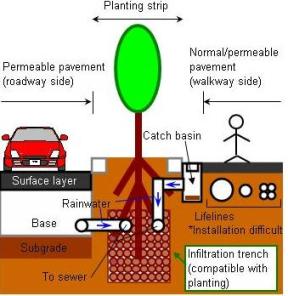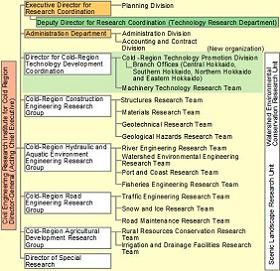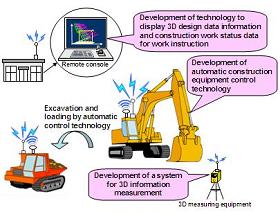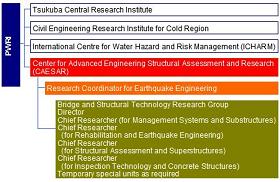Joint Research workshop held with Korea Expressway Corporation ETRI
 Workshop participants |
 A scene at the workshop |
 Test course (two lanes on the near side) |
On February 27 and 28, 2008, PWRI held a joint research workshop with the
Korea Expressway Corporation ETRI (Expressway & Transportation Research
Institute) in Hwaseong City near Seoul, South Korea. PWRI and ETRI have
a research cooperation agreement, and this first joint research workshop
focused on research in the field of concrete structures conducted by the
two organizations.
At the workshop, research results were presented and views were exchanged
on high-strength concrete and durability of concrete structures. The Korea
Expressway Corporation is currently considering using high-strength concrete
and opinions were exchanged regarding the surrounding issues, including
problems and results of actual use in Japan and the research results of
past experiments conducted by the Structure Management Technology Research
Team.
One topic related to durability of concrete structures was PWRI's report
on the results of research into the quality control of concrete and technology
for diagnosing and repairing concrete structures deteriorated by chloride
attack and alkali-aggregate reaction. The ETRI presented its predictions
on deterioration of concrete structures caused by chloride attack and damage
to concrete pavement caused by alkali-aggregate reaction.
In addition, an opportunity was given to visit the ETRI's test course as part of the workshop. The large test course, with a total length of 7.7 km, was constructed in 2002 for the purpose of studying the durability of multiple paving methods. According to ETRI, the test course, which was built alongside a currently operating expressway, is placed in service once a year to monitor the impact of the actual traffic load via sensors embedded in the pavement.
The maintenance of existing concrete structures is recognized as a significant research topic in South Korea as well as in Japan, and opinion exchange has helped in understanding the present state of research and development taking place in the two countries. This workshop is expected to be held on an ongoing basis as an opportunity for information exchange between the two organizations.
(Contact: CAESAR)
Demonstration of Robotics Construction Held
On February 25, 2008, a demonstration of robotic construction equipment
capable of earthworks (hydraulic excavator excavation and loading) and
with a certain degree of autonomy was held at PWRI's construction machine
test field. This demonstration was intended to present the results of the
activities of the General Technology Development Project by the Ministry
of Land, Infrastructure, Transport and Tourism(MLIT) Development of Construction Robots and Associated IT Systems (implemented between FY2003 and FY2007), to members of the committees that supported said project: "the Committee for lT-assisted Construction Systems Using Robots (Chairman: Professor Yuta, University of Tsukuba)" and "Subcommittee I: Robotic Construction Subcommittee (Chairman: Professor Asama, University of Tokyo)". The secretariat for this project was the Advanced Technology Research Team.
In this project, three fundamental technologies have been integrated to develop a prototype of IT construction system: (1) technology to recognize the surrounding environment as 3D information required for autonomous construction work (recognition of the surrounding environment that continuously changes from hour to hour as the work progresses), (2) technology to display 3D information required for operation (man-machine interface) and (3) technology to automate construction work operation (robotic construction equipment control technology). The functions were demonstrated on this occasion.
The event began with an opening address by Chairman Yuta, Professor at the University of Tsukuba, which was followed by an overview demonstration based on the demonstration scenario, Q&A session, and discussion.
The demonstration included a construction site experiment simulating unmanned construction work at a disaster site. A tent made to represent a remote work station where instruction and monitoring is conducted was set up at a location away from a site where excavation and loading is conducted with a hydraulic excavator. In the remote control room, the CG display that has been developed (3D display of plane and sectional views of the design and current topography via computer graphics, real-time 3D model display of the status of construction equipment, etc.) and video superimposition display (real-time display of an image from the video camera mounted on the construction equipment superimposed with a design model) were installed to demonstrate the movement of the construction equipment by remote control, check the excavation/loading positions against the CG display, monitor automatic excavation and loading, check working form against the CG display, etc.
After the demonstration finished, active discussion took place among the committee members, who offered many valuable opinions.
Going forward, we anticipate further improvement of work efficiency by unmanned construction work and manpower saving and reduction of occupational accidents in general construction sites thanks to this technology.
Last but not least, the preparation and operation of this demonstration would not have been possible without the cooperation of many people. We would like to extend our sincerest thanks to all of you present and all concerned who have given us their cooperation.
(Contact: Advanced Technology Research Team)
The Tsukuba Meeting of the US-Japan Conference on Flood Control and Water Resources Management held
 Six engineers from the US Army Corps of Engineers |
 Welcoming address by Chief Executive Sakamoto |
 Director Christopher N. Dunn giving a presentation |
On February 27, 2008, water experts from the United States visited the PWRI in Tsukuba and had a meeting with Japanese counterparts to talk about a wide range of water issues.
This meeting followed the 4th US-Japan Conference on Flood Control and Water Resources held on the previous day at Mita Kaigisho in Tokyo (the conference is held based on the agreement, signed on March 18, 2003, between the Japanese Ministry of Land, Infrastructure, Transport and Tourism (MLIT) and the US Army Corps of Engineers (USACE), Department of Defense). Six engineers from the US delegation, led by Dr. Christopher N. Dunn, director of the Hydrologic Engineering Center, attended the meeting.
USACE is a US organization in charge of nationwide flood control as part
of the country's national defense. Last June, ICHARM of PWRI entered into
a comprehensive research partnership agreement regarding flood prevention
and mitigation with the USACE-affiliated Institute for Water Resources
(IWR), which is based in Washington, DC.
In the meeting at PWRI, presentations were given at the ICHARM auditorium on such topics as levee safety assessment, river environment management, and flood risk management including global climate change adaptation. Each presentation was followed by a Q&A session and discussion. Dr. Dunn was the first speaker to deliver a presentation on the theme of the "Engineering and Mathematical Approaches to Risk Management", and then PWRI researchers spoke on the following three subjects:
-Challenges Facing Water-related Disaster Management
-Integrated Geophysical Exploration Technology for River Levee safety assessment
-Regeneration of River Environment in View of Historical Changes in River Environment.
As large floods are likely to be more frequent due to global climate change, it is important to steadily implement effective flood control measures in due consideration of the conservation of natural environment while building taxpayer consensus. Experts from both countries should continue to meet at this conference to promote bilateral cooperation in frank exchanges of information and experience that are useful to facilitate solutions to challenges each country faces today.
(Contact: ICHARM)
Tour of Construction Project Related to Planting Infiltration Trenches
 Conceptual diagram of an infiltration trench compatible with planting |
 Tour of construction work  Q & A session |
In recent years, the building of "infiltration trenches" that bring rainwater into the ground at parks and roads is called for as a means to store rainwater based on the enforcement of the Law for Urban Flood Damage Mitigation Measures in order to mitigate flood damage in urban areas, in consideration of natural environment by groundwater recharge and as reservoirs to address the heat island effect.
In reality, however, the closer to urban areas, the more difficult building of infiltration trenches is because many lifelines are installed and excavation takes place frequently to replace buried pipes and other facilities on the walkway side of roads.
For this reason, focus has been given to planting strips as a location
free of longitudinally buried lifelines that is not subject to frequent
excavation in order to pursue the development of infiltration trenches
compatible with planting (hereafter "planting infiltration trenches").
The Construction Technology Research Team held a tour of a planting infiltration trench construction project intended for local governments, general contractors, construction consultants, and manufacturers on March 19 to introduce planting infiltration trenches and offer related proposals.
On the day of the tour, a total of 73 people participated, including 51 from local governments and associations and 22 from private corporations.
First, we summarized the main points of planting infiltration trenches
at ICHARM's auditorium, after which the group moved to the construction
site to observe of how each step of the project would proceed. Lastly,
a questionnaire and Q&A session were conducted back at the auditorium.
The biggest benefits of planting infiltration trenches include: (1) multifunctionality
of flood control, ground water recharge, and heat island mitigation functions,
(2) availability thanks to low cost, extremely simple construction work,
and (3) capability of quantitative assessment and design by city block
or large area by enclosing a target area with infiltration trenches. This
is because planting infiltration trenches are capable of linear storage
and infiltration, whereas infiltration trenches in parks can only store
and infiltrate in dispersed locations.
The participants showed a lot of interest in the infiltration trenches compatible with planting and we were asked a great number of questions. In order to accurately understand and assess the effects of these planting infiltration trenches, they must be actually built field to check and verify their effect. We intend to use this tour as the starting point in our collaboration work with local governments, construction consultants, general contractors, and manufacturers to accomplish field construction and check and verify the effects thereof.
We would like to extend our deepest thanks to the participants, who took the trouble of visiting in spite of their busy schedules, and all those who assisted in the preparation and operation of this tour.
(Contact: Construction Technology Research Team)
Courtesy visit by Mr. Mosqueira, Deputy Chief of the Peru National Institute of Civil Defense
 Deputy Chief Mosqueira (center) receiving an explanation from Chief Executive |
 Deputy Chief Mosqueira bangs the liquefaction reproduction equipment |
On March 25, 2008, Mr. Mosqueira, Deputy Chief of the Peru National Institute of Civil Defense (INDECI), and Mr. Alvarado, Head of SPCCC of INDECI visited the Ministry of Land, Infrastructure and Transport (MLIT)-affiliated institutes in Tsukuba. The two officials were invited to Japan under the auspices of the construction economy exchange promotion project (VIP invitation project) promoted and implemented by the Policy Bureau of the MLIT, in which MLIT-related measures were introduced. Their visit to Tsukuba research institutes was held based on a Peruvian government request for the two to visit during their stay.
Mr. Mosqueira received an explanation at the Chief Executive's Office about the circumstances behind the establishment of Tsukuba Science City. He expressed his appreciation for Japan's assistance in response to the earthquake disaster that hit the coast of Peru in August 2007 as well as his desire to make good use of our researchers' methods and ideas for disaster prevention in Peru for to help prevent future disasters.
We introduced disaster-related research conducted at PWRI; Osamu Matsuo, Director of Earthquake Disaster Prevention Research Group and Akira Terakawa, Director of Water-related Hazard Research Group explained about the research and training activities taking place at the Earthquake Disaster Prevention Research Group and International Center for Water Hazard and Risk Management (ICHARM), and Kazunori Fujisawa, Chief researcher of the Landslide Research Team, presented methods for monitoring debris flow and landslide slopes after volcanic eruptions. Mr. Mosqueira showed interests in the latest research and training for flood disasters and asked many questions about the responses given in Peru.
At the International Conference Room of the National Institute for Land and Infrastructure Management, Mr. Mosqueira gave a general presentation on Peru and the current state of the earthquake disaster. At the vibration testing facility, he showed an interest in the liquefaction reproduction equipment capable of reproducing liquefaction phenomena, which is an issue in earthquakes in Peru, and saw how liquefaction developed by banging the equipment himself.
(Contact: Planning and Management Division)
New CERI Coming Soon!
 CERI organization chart |
 Branch locations |
To address the transfer of the engineering development operations, which is to be carried out by the Hokkaido Regional Development Bureau of the Ministry of Land, Infrastructure, Transport and Tourism(MLIT) starting on April 1, 2008, Civil Engineering Research Institute for Cold Region (CERI) has established the Cold-Region Technology Promotion Division with four branch offices in Hokkaido (Central Hokkaido, Southern Hokkaido, Northern Hokkaido and Eastern Hokkaido) and the Machinery Technology Research Team under the Director for Cold-Region Technology Development Coordination.
CERI is committed to striving as one for the promotion of research and development, including new fields of research, to provide a comfortable living environment for the public through even more advanced research. We appreciate your continued and future understanding and cooperation.
Introduction the new organization
Director for Cold-Region Technology Development Coordination
Duties include coordinating research themes and technology development.
Cold-Region Technology Promotion Division and Branch Offices
Cold-Region Technology Promotion Division
Duties include planning surveys concerning new technologies and cost reduction
technologies for cold regions.
Duties including Planning and coordinating related to the guidance and
diffusion of achievements.
Branch Offices
Duties include field surveys related to research themes for cold regions.
Field surveys related to the improvement and use of new technologies and
cost reduction technologies for cold regions.
Machinery Technology Research Team
Duties include survey research related to the advancement of construction
work and facilities maintenance technologies in cold regions.
(Contact: Planning Division, CERI)
Inauguration of CAESAR
Japanese road structures such as bridges are subject to high traffic demand and severe natural environments. In addition, structures built in large numbers during the high economic growth period will enter old age at the same time. Under these circumstances, we must quickly establish technologies to maintain and assess the soundness of such road structures.
To address this issue, PWRI reformed its existing research organization on April 1, 2008, and established Center for Advanced Engineering Structural Assessment and Research (CAESAR) in addition to the three existing research institutes.
At CAESAR, the traditional team system has been abolished and integrated research will be conducted for the entire process, from the design and construction to maintenance of road structures, and the maintenance system and technologies for repair, assessment, and inspection.
Four missions of CAESAR
(1) Clinical trials and research
Together with road administrators, CAESAR provides sound maintenance of structures such as highway bridges, problem solving techniques to address earthquakes, and research to that leads to solutions.
(2) Collection and dissemination of technology
CAESAR collects and disseminates information on design, construction, and maintenance technology for highway bridges.
(3) Putting state-of-the-art treatment into practice
CAESAR works on standardizing research achievements and accumulated technologies so that they can be given back to society.
(4) Education for engineers
CAESAR invites engineers and researchers from road administrators, universities, and the private sector to work together to improve technical capabilities.
Three pillars of research
- To prevent the nation's infrastructures from decaying
- To enable a disaster resilient nation
- To provide performance-based design and verification measures
CAESAR operation intends to respond flexibly and appropriately to the needs of society and road administrators across existing research frameworks. We appreciate your support and cooperation.
(Contact: CAESAR)





